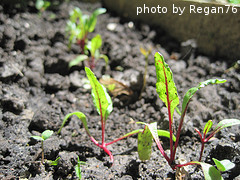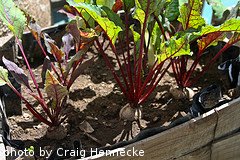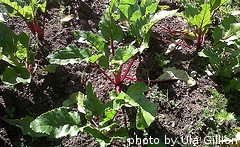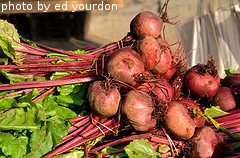How To Fertilize Beets and Water Them
Want to learn how to fertilize beets? You've come to the right place. Because they are a fast growing crop, we recommend adding fertilizer or compost to the soil before planting beets. When it comes to watering beets, be pay attention to how well the soil drains. Like other root vegetables, beets tend to rot if they sit in soggy soil for extended periods of time. On the other hand, they won't grow well if they don't get enough water.
How To Fertilize Beets

Most varieties of beets are ready to harvest in about 2-3 months, sometimes even less. Because of this, we like to add nutrients to the soil before planting. Compost and well-rotted manure work fine, as does a granular fertilizer product. Just make sure to apply it early enough to be able to work it into the soil and then water it in before planting.

When choosing a fertilizer, look for something with more phosphate and potassium and less nitrogen. Pay attention to the 3 number code on the package of fertilizer. These three numbers indicate the amount of nitrogen, phosphate and potassium that are contained in that particular fertilizer, respectively. For instance, a 10-10-10 fertilizer contains 10% nitrogen, 10% phosphate and 10% potassium. A 5-10-10 bag would contain 5% nitrogen, 10% phosphate and 10% potassium. Nitrogen encourages a plant to produce more foliage. Phosphate and potassium encourages more root development. Because beets are a root vegetable that grow below the surface of the soil, phosphate and potassium are more beneficial to beet growth.
In our own garden, we apply a balanced granular fertilizer to the area at a rate of 1 pint per 100 square feet. We also apply pulverized lime since our soil is acidic and slightly calcium deficient. We do this before we even plant our beet seeds. Then we till one last time to work the fertilizer and lime into the soil. Once the beets sprout, we often use a water-soluble fertilizer that has a bit more phosphate and potassium and a little less nitrogen. We typically apply this fertilizer once during the growing season.
If you want to grow beets more organically, compost, well-rotted manure, bone meal and wood ashes all work fine for growing beets, depending on the make up of your soil. You can work them into the soil before planting, and/or use them as a side dressing when the plants sprout.
Watering Beets

Beets will do well with several moderate watering sessions, as opposed to a single deep soak. To check to see if your beets need to be watered, dig down into the soil with your fingers near your beets crop. You want the soil at 3-4 inches deep to be slightly moist, but not wet. Squeeze a handful of dirt in your palm. You want it to hold together for a few seconds before falling apart. If it's wet or soggy and stays in a ball when squeezed, hold off on watering and check the soil again in a couple of days. If it's dry and crumbles in your hand without holding together at all, give the beets a moderate soak. If you don't get any rain at all, a light to moderate watering twice a week is usually enough.
When watering, be careful not to wash away the soil around the beets. This is especially important if you are growing them in raised rows. We find that a simple oscilating, overhead sprinkler does a good job of getting the ground wet without causing too much soil erosion. Leave it on your beet crop for about 10-15 minutes or so, and that's usually long enough to give them the water they need.
We like to water in the early morning hours, so that the moisture evaporates off the leaves by the afternoon. This leads to less pest and disease problems in your garden. In addition, we try to avoid watering our beets the last week or so before we harvest them. We think this leads to sweeter roots and more flavorful tops.
To help the soil retain moisture and to prevent erosion, you can use mulch around your beets. Grass clippings, straw or chopped up leaves work well for mulch. It's best to wait until the beet tops are a few inches tall before adding mulch. Mulching also makes harvesting the tops easier and more enjoyable because they are usually less gritty and dirty. Another benefit of mulch is that at the end of the growing season, you can just till it into your soil, and it will break down and add nutrients to your garden plot.

Now that you know about how to fertilize beets and water them, it's time to think about harvesting them.
Click here to learn about harvesting beets
Click here to move from our How To Fertilize Beets page to our Growing Beets main page
Click here to go to our Home page